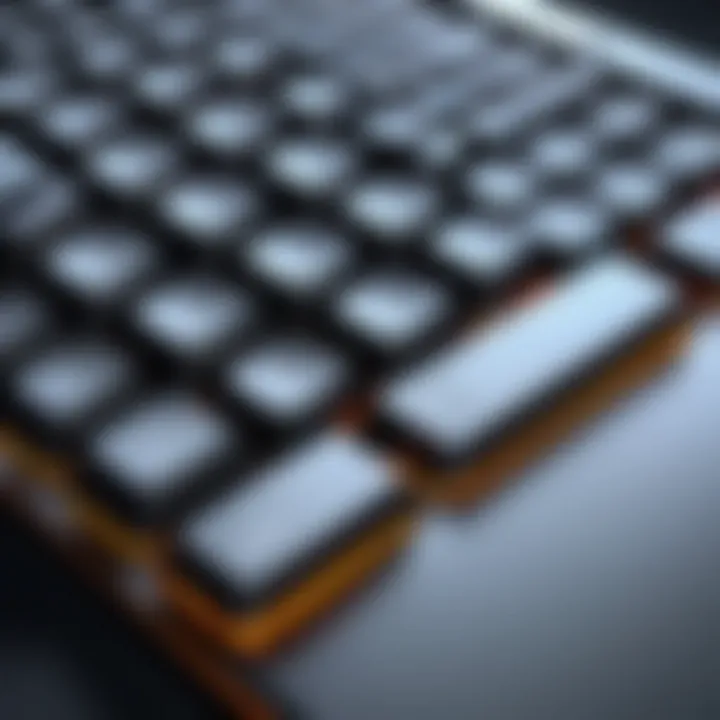Achieving a Quieter Keyboard Experience for Professionals


Intro
In a world where sound pollution is on the rise, finding a way to minimize noise, particularly during activities like typing, has gained prominence. For many, the keyboard is a primary tool used daily, whether for work, gaming, or leisure. The distinct sounds produced by different keyboards can be grating not only for the typist but also for those in close proximity. This need for a quieter typing experience drives the exploration of various keyboard types and the modifications that can lessen the auditory impact while maintaining a satisfying usability experience.
By the end of this discussion, readers will have comprehensive knowledge about the methods available to them, helping them make informed decisions tailored to their specific needs. This exploration is relevant as it connects to a broader conversation about productivity, comfort, and ergonomics in modern work environments.
Next, we will look closely at the keyboards available today and evaluate their specifications, performance, and suitable environments.
Intro
In the modern world, keyboard noise can often go unnoticed, yet its significance cannot be understated. A quieter typing experience affects a broad range of environments, from bustling office spaces to serene home setups. This article seeks to explore both the need for reducing keyboard noise and the practical strategies that can be employed to achieve this goal.
One reason for emphasizing quiet keyboards lies in their impact on productivity. In office scenarios, sound levels can directly influence focus and efficiency. Exposure to continuous typing noise from colleagues can create distractions, forcing individuals to expend mental energy trying to filter out the unwanted sounds. This can lead to decreased productivity and increased frustration over time.
Furthermore, the relevance of a quieter keyboard extends beyond individual productivity. In shared spaces, collaborative work often necessitates an atmosphere conducive to concentration. A noisy keyboard disrupts not only the typist but also those working nearby. In environments like libraries or open-plan offices, maintaining a calm atmosphere is essential for fostering creativity and innovation. A quiet typing experience allows for a more harmonious coexistence among teammates or fellow patrons.
Considerations about keyboard noise also take into account the preferences of specific user groups. Gamers, for instance, might appreciate silence during long gaming sessions, as background noise can detract from immersion. On the other hand, professionals focusing on lengthy writing or coding tasks may find that excessive sound levels create discomfort after extended periods. Ultimately, achieving a balance is critical for ensuring comfort and efficiency while using keyboards in various contexts.
In this article, we will delve into the world of keyboards, analyzing their noise levels and how different types influence the typing experience. We will look into specific mechanical and membrane options, focusing on modifications and accessories that can enhance quietness. With a wealth of insights and practical solutions, this guide aims to equip tech enthusiasts, gamers, and IT professionals with valuable knowledge to curate quieter typing experiences.
The Importance of a Quiet Keyboard
The significance of a quiet keyboard in today’s increasingly noise-sensitive environments cannot be overstated. As more individuals find themselves working from home or in open office layouts, the need to minimize distractions has become paramount. A quieter keyboard can enhance focus, foster more effective communication, and ultimately lead to increased productivity. Understanding the importance of noise levels not only highlights a keyboard’s functionality but also speaks to human psychology and efficiency.
Impact on Productivity
A quieter typing experience directly correlates with improved productivity. When the keyboard produces less noise, users can immerse themselves in their work without distraction. Loud, clattering keys can disrupt thought processes and break concentration. This is especially true in professions that require deep focus, such as programming or writing. Studies have shown that quieter working conditions can lead to longer attention spans and better overall performance. This is due to the cognitive load reduced by minimizing auditory distractions.
Furthermore, a quiet keyboard allows for smoother collaboration in team settings. When team members can type and communicate without overwhelming background noise, ideas flow better, and discussions become more coherent. An environment that supports productivity is beneficial not only for individual users but also for teams and organizations.
Reducing Workplace Distractions
Workplace distractions come in many forms, from conversations to the sounds of typing. A noisy keyboard contributes significantly to the auditory clutter of any workspace. This noise can break concentration and prompt workers to shift their focus away from tasks. By opting for quieter equipment, employees can reduce the overall noise level, creating a more conducive space not just for themselves but for others around them.
Moreover, the psychological benefits of a quieter workspace should not be overlooked. Reduced noise helps to lower stress levels, which can enhance overall job satisfaction and employee well-being. When distractions diminish, workers may feel more in control and engaged in their tasks. Thus, investing in a quieter keyboard becomes an essential step in cultivating a more productive and harmonious work environment.
Benefits for Shared Spaces
In environments such as offices, co-working spaces, and libraries, noise management is essential for everyone involved. A quieter keyboard helps facilitate a shared atmosphere where focus and collaboration thrive. By minimizing typing sounds, employees can respect the need for quiet while still accomplishing their work duties. This approach is particularly crucial in shared and communal areas, where a balance must be struck between individual productivity and collective tranquility.
In addition, quieter keyboards can foster a sense of professionalism and courtesy. Colleagues are likely to appreciate the consideration of limiting noise pollution, creating a more pleasant atmosphere for collaboration. It also aligns with best practices in ergonomics, promoting healthier work habits.
Thus, the value of a quiet keyboard extends beyond the individual; it enhances the collective dynamics in any setting that relies on collaboration and focus.
Types of Keyboards and Their Noise Levels


Understanding the types of keyboards and their corresponding noise levels is a fundamental aspect of achieving a quieter typing experience. Different keyboard designs contribute to varying noise outputs, which plays a critical role in settings where sound reduction is necessary. In environments such as offices, libraries, or shared workspaces, choosing a keyboard that minimizes noise can significantly enhance comfort and productivity.
When evaluating keyboard noise, it is important to consider both the construction and the technology behind each type. This section will explore three prominent categories: mechanical keyboards, membrane keyboards, and chiclet or laptop keyboards. Each type has its own unique characteristics affecting sound levels and user preferences.
Mechanical Keyboards
Mechanical keyboards are favored by many for their tactile feedback and durability. However, not all mechanical keyboards are created equal in terms of noise levels.
Switch Types
Mechanical keyboards use various types of switches, each contributing differently to the overall sound profile. Switches such as Cherry MX Silent Red or Gateron Silent Brown are examples that prioritize sound dampening while still offering good tactile feedback.
The key characteristic of silent switches is their design, which significantly reduces the noise when a key is pressed. Their smooth operation makes them a popular choice amongst users looking for quieter alternatives. These silent switches do carry some disadvantages, such as being less widely available and sometimes more expensive compared to standard switches.
Sound Characteristics
The sound characteristics of mechanical keyboards largely depend on the type of switch. For instance, clicky switches create a more distinct sound, while linear switches offer a much quieter typing experience. This distinction is essential for users who aim for a noise-free environment.
The advantage of focusing on sound characteristics is that they not only influence noise levels but also affect typing speed and accuracy. However, potential drawbacks include users' varying preferences for feedback noise, which can lead to a trade-off between quietness and tactile satisfaction.
Membrane Keyboards
Membrane keyboards are often considered the quieter companions to their mechanical counterparts. They function differently, which affects both feel and sound.
Construction and Sound Dampening
A membrane keyboard consists of three layers of rubber or silicone. This construction compresses when a key is pressed, resulting in a softer sound profile. Such keyboards are ideal for users who value silence during typing.
The highlight of this construction is its inherent sound dampening properties. This feature makes membrane keyboards extremely suitable for environments where silence is crucial, such as offices or libraries. However, this design can result in less distinct tactile feedback, which might not appeal to all users.
Typical Noise Levels
Typically, membrane keyboards produce lower noise levels compared to mechanical options. The sound generated is often described as a soft thud, much less intrusive than the click found in mechanical switches.
This characteristic is beneficial because it creates a more conducive atmosphere for concentration. However, some users may find the lack of feedback less satisfying, which could potentially impact their typing experience.
Chiclet and Laptop Keyboards
Chiclet keyboards, commonly found on laptops, provide another excellent alternative for quieter typing.
Design and Noise Features
Chiclet keyboards feature flat, separated keys that often result in a quieter operation. The design minimizes the space between keys, leading to a more uniform sound when typing.
The advantage here lies in their compact nature and modern aesthetic, making them suitable for both casual and professional setups. However, users accustomed to mechanical keyboards may find this design offers less tactile feedback.
Usability in Quiet Settings


Chiclet keyboards are built to function well in various settings, especially quiet environments. Their design allows for effective noise reduction, which is crucial for meetings or collaborative workspace settings.
However, while they are practical in terms of noise output, some users may consider their durability lacking compared to mechanical offerings, leading to concerns about long-term use.
Ultimately, the choice of keyboard type can greatly influence the noise level and overall typing experience. Knowing the specific characteristics of each can guide users to find the right fit for their needs.
Mechanical Keyboard Options for Reduced Noise
In the realm of typing equipment, mechanical keyboards are often favored for their tactile feedback and durability. However, they can also produce substantial noise, which makes them less suitable for quiet environments. This section examines options to minimize noise while retaining the desirable qualities of mechanical keyboards. More specifically, selecting the right components can lead to a significant reduction in sound without sacrificing performance. This focus on quieter alternatives is essential for users who require a peaceful workspace, whether for personal preference or professional settings.
Silent Switch Alternatives
Types of Silent Switches
Silent switches are designed to minimize sound during keypresses. Unlike traditional mechanical switches, these alternatives employ specialized mechanisms that suppress noise. For example, Cherry MX Silent Red switches are a popular choice, known for their linear feel and reduced click sound.
The crucial characteristic of silent switches is their ability to provide a soft landing for the keycap. This feature is typically found in dampened designs, which often utilize additional plastic components to absorb sound. As a beneficial choice in this article, silent switches maintain a similar typing experience without the distracting noise of clicks typical in mechanical keyboards. These variations can greatly benefit users in quiet settings.
Performance Insights
Understanding performance insights is important when selecting silent switches. Many technological reviews indicate that silent switches offer similar actuation force as their louder counterparts. For example, Cherry MX Silent Red switches act at 45g but produce less sound, balancing the need for tactile feedback and minimal noise.
A unique feature of these switches is their excelent responsiveness, as they are designed for frequent typing without wear. The advantages lie in their combination of low-noise operation and ability to perform during extensive use, making them suitable for gamers and professionals alike.
O-Rings and Sound Dampeners
Installation Process
Using O-rings can further reduce sound when typing on mechanical keyboards. The installation process is not complex and can be performed with minimal tools like a keycap puller. Most O-rings can be installed underneath keycaps, cushioning the impact when typing. This process benefits the user by minimizing sound with each keypress.
The key characteristic of this installation is ease of use. With O-rings, users can enjoy the quiet typing experience without needing to replace entire keyboards. The unique benefit lies in their affordability; they are a budget-friendly option to reduce noise effectively.
Efficacy in Noise Reduction
There is considerable discussion around the efficacy of O-rings in noise reduction. While some users report significant decreases in noise levels, others find the results less impactful. It’s important to remember that O-rings may lower the volume of sounds but might not eliminate them entirely.
The characteristic that influences this efficacy is the thickness of the O-rings used. Thicker O-rings generally provide better dampening, but they can alter the feel of the keys. Therefore, users must weigh the advantages of reduced noise against potential discomfort in typing.
Custom Keyboards and Modding
Building a Quieter Keyboard
Building a custom keyboard can be an effective method to achieve a quieter typing experience. This process involves selecting components that specifically cater to reduced noise, like silent switches and appropriate dampeners. Many enthusiasts find satisfaction in constructing keyboards tailored to their personal preferences.
The key characteristic of building a quieter keyboard is that it allows the user full control over the materials and features. This creates a unique experience for each user, focusing explicitly on minimizing sound. Additionally, the satisfaction of crafting a custom keyboard can surpass the benefits of using mass-produced alternatives.


Modifications for Professional Use
Modifications for professional use can also enhance the ability to create a quieter keyboard. These tweaks might include advanced sound-dampening methods or specialty keycaps designed specifically for a low-noise operation. Professionals working in shared spaces often find these modifications necessary to maintain focus.
The unique aspect of these modifications lies in their adaptability. Users can modify existing keyboards or create entirely new models that align with their sound requirements. These adaptations can effectively cater to environments where concentration is paramount.
Overall, by exploring silent switches, O-rings, and custom keyboard modifications, one can effectively achieve a quieter keyboard experience tailored to personal and professional needs.
Integrating these solutions will help improve the typing experience while addressing noise concerns.
Accessories for a Quieter Typing Experience
Accessories play a significant role in enhancing the typing experience, particularly when noise reduction is a priority. They serve to bolster the effectiveness of keyboards to keep sound levels down. For many users, especially those in shared work environments or home offices, the right accessories can mean the difference between a peaceful workspace and a noisy distraction. A variety of accessories can be used to limit keyboard noise, including mats, desk pads, and wrist supports.
Keyboard Mats and Desk Pads
Insulation Properties
Insulation properties are critical in minimizing the sound produced by key presses. Keyboard mats and desk pads can absorb vibrations, which helps to dampen noise effectively. The main characteristic of these mats is their ability to provide a cushioning surface under the keyboard. This not only reduces sound transfer but also enhances comfort during prolonged use.
A unique feature to consider is the thickness of these mats. Thicker mats tend to offer better insulation, leading to quieter keystrokes. However, they may not be suitable for all keyboard types, as some users prefer stability over cushioning. Overall, investing in a high-quality mat can lead to a noticeable decrease in noise—an essential benefit for those seeking a quieter typing experience.
Material Options
The material options available for keyboard mats and desk pads significantly affect their sound-dampening abilities. Popular materials include rubber, foam, and fabric. Each of these options has its unique characteristics that contribute to noise reduction. For instance, rubber mats often provide excellent grip and absorb vibrations well, making them a popular choice among users.
On the other hand, foam mats may offer enhanced comfort but can wear out faster. Fabric options often provide a softer feel, yet may not absorb sound as effectively as rubber or foam. Different materials can suit different preferences, but selecting a quality material that aligns with your needs will greatly enhance your typing experience.
Wrist Supports
Impact on Typing Mechanics
Wrist supports can have a significant influence on typing mechanics, contributing to overall comfort and ergonomics. By providing the necessary support, they can help to maintain a neutral wrist position, reducing strain during typing. The key characteristic of these supports is their ability to offer aligned support, which can lead to fewer errors and faster typing, as users can maintain a comfortable posture.
A unique feature of wrist supports is that they can reduce the impact sound made during typing. When the wrists are properly positioned, the force exerted on the keys may be lessened, resulting in softer key presses. Although not all supports offer equal sound-dampening capabilities, those that provide adequate cushioning can lead to quieter typing sessions.
Choosing the Right Support
Choosing the right wrist support is crucial for effective noise reduction and overall comfort. Various types of supports are available, such as gel-filled, memory foam, or traditional cushions. Each type has its advantages and disadvantages that cater to different user preferences. For example, gel-filled supports often mold to the user's wrist but may lack breathability, potentially causing discomfort over time.
Memory foam offers a good balance between support and comfort, conforming to the shape of the wrist without causing excessive heat buildup. Ensuring that the support chosen aligns with the user's specific typing style will optimize both comfort and noise reduction, ultimately enhancing the typing experience.
In sum, selecting the right accessories is essential for enhancing a quieter keyboard experience. From effective keyboard mats that insulate sound to wrist supports that improve typing mechanics, every element plays a role in achieving the desired quietness and comfort.
Ending
This article presents a variety of strategies for reducing keyboard noise, emphasizing its benefits for both personal and collective settings. It highlights the role of different keyboard types, ranging from mechanical to membrane variants, providing insights into their noise levels and sound characteristics. Each type offers unique advantages and disadvantages that cater to the varying preferences of tech enthusiasts, gamers, and IT professionals.
Moreover, exploring the available technologies—like silent switches, O-rings, and sound dampeners—illustrates that effective modifications are within reach for those seeking tranquility in their typing. Accessories such as keyboard mats and wrist supports further contribute to a quieter experience, reinforcing the notion that small adjustments can yield significant benefits.
Ultimately, the relevance of this topic stretches beyond mere convenience. It enhances workplace dynamics, increases personal productivity, and fosters a more pleasant environment for collaboration. The conversation around keyboard noise must continue to evolve as technology advances, and as professionals strive for better acoustic solutions in their daily routines.
"A quieter keyboard leads to a more focused mind, improving the effectiveness of both work and play."







